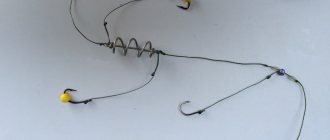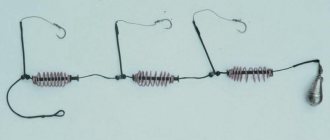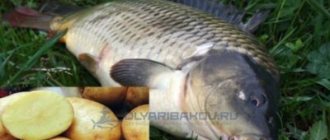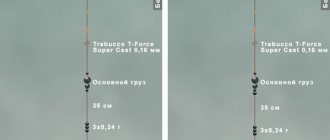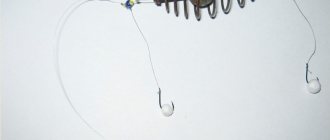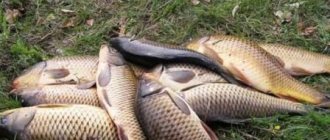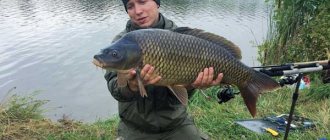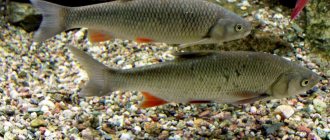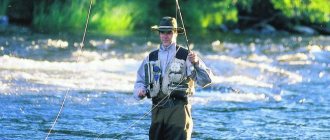Who doesn't dream of catching a big carp? But the attachments for it on sale today are far from cheap. In fact, you can assemble a carp kit with your own hands, which will work just as well as purchased gear. Carp is a bottom-dwelling fish and it is still necessary to know some behavioral features, biting places, and also to show some persistence and patience.
Installation of equipment: step-by-step process
You can make many different rigs with your own hands: helicopter, clip, inline, sliding, crucian carp killer, Gardner paternoster, which do not require special equipment and are made right at the fishing spot.
Excellent for carp fishing and signals bites with inline equipment. To make such equipment you need to select:
- fishing line 1 meter long;
- a feeder in the form of a cage with a clasp in the form of a weight;
This is a simple and effective design. For installation:
- wind the fishing line onto the reel;
- bend the fishing line in half;
- make a knot at a distance of 0.5 m from the edge;
- attach the sinker to the feeder;
- attach a piece of fishing line for a leash 20-25 m long;
The feeder can be attached in several ways. This is an excellent rig option for muddy bottoms with the bite transferred to the tip of the rod. The leash will not go under the water with the feeder, which will ensure excellent performance of the tackle when fishing.
Hair rig
Without putting bait on the hook. The equipment includes hair, a strong hook, and a soft fishing line of large diameter. When making equipment, the bait is fixed at a distance of 20 cm from the end of the fishing line. Several turns of hair are made with the possibility of lengthening at any time.
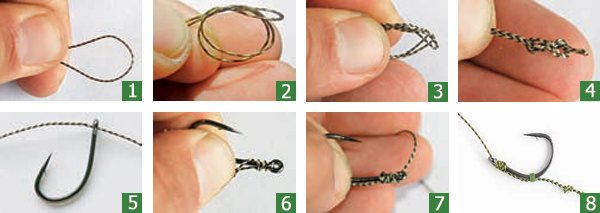
Helicopter
Does not have a rigid connection between the sinker and the leash. Well suited for long casts. Depending on the application conditions, you can change the distance between the leader and the load.
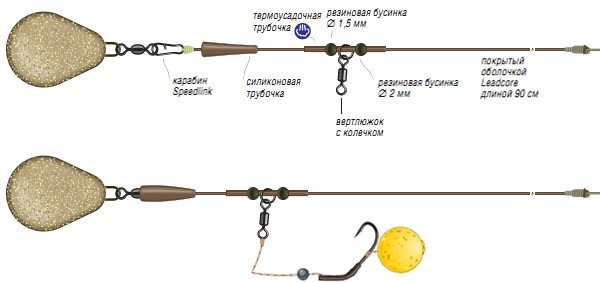
For installation:
- tie a piece of fishing line;
- connect the lead core with the sinker;
- put in a ring;
- place two stoppers between the load and the leadcore;
- make a ring and connect it to the leash;
- tie the leash to the ring, then to the leadcore;
Clip
A favorite among carp gear, a safe rig with a tightly attached weight.
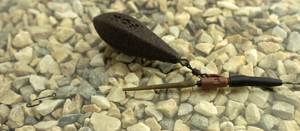
For installation you must have a sinker, a swivel, a tube for equipment, a cone, a coupling, a clip, a tube 20 cm long:
- put a clip on the fishing line;
- pass the fishing line through the cone coupling;
- attach the swivel;
- attach to leash;
Inline
Suitable for carp fishing in low currents in lakes and reservoirs for long casts. But the leashes often get tangled, and the sensitivity of the structure may decrease significantly.
Sliding equipment
With free movement along the line. It is quite sensitive and will not cause the tackle to tilt under the weight of the weight and it will not be difficult to make a timely hook.
To install the sliding equipment, you need to select a latch, a sinker, a silicone tube, a buffer sleeve, and a swivel with a ring:
- put the tube on the fishing line;
- connect the leadcore to the swivel;
- pull through the ring and buffer sleeve;
- attach the swivel to the latch and then to the silicone tube;
- mount the weight;
- last of all, connect the hooks to the leash;
carp killer
Reliable equipment; for installation you will need: hooks (3 pieces) No. 6, rubber stopper, weight, swivel and fishing line:
- put a sinker and a swivel on the fishing line with a latch;
- pass the fishing line through all the springs;
- fix;
- tie a weight with a leash;
- install the swivel and latch. At this point the equipment is ready;
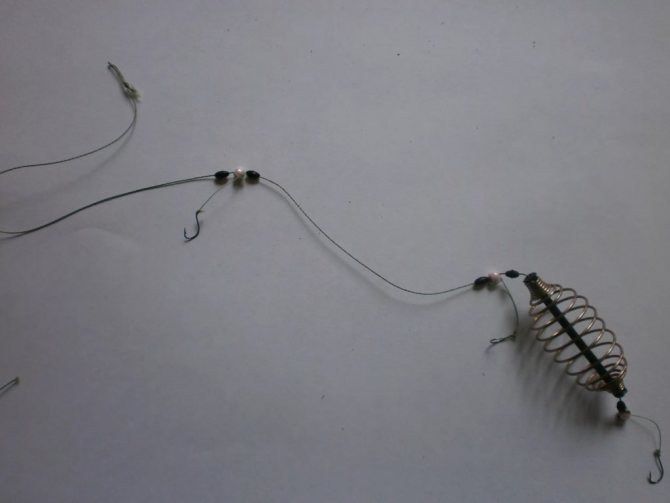
Gardner's Paternoster
Does not require additional devices for installation. You can make it right at the fishing spot. The rig will always be above the surface of the water, regardless of whether the feeder is full or empty.
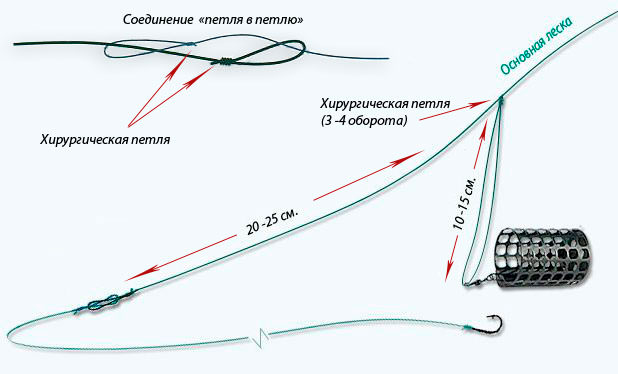
How to make crucian carp killer tackle
You can make killer tackle yourself. To do this you will need: • 3 spring feeders without weighting (this is a must!); • 3 hooks. The size depends on the size of the intended fish, the smaller the better; • Sinker weighing 30-50 g; • Mono line with a diameter of 0.3 mm; • Swivel;
Assembly instructions:
- The sinker is attached to the swivel, so it is better if it has an eye.
- A spring is tied to the swivel with fishing line. The distance between them is 8-10 cm. It is better to choose feeders with a tube. In this case, the fishing line is passed through, and rubber stoppers at the edges will limit the movement of the spring along it. In any case, the spring should not move freely along the line.
- 2 more feeders are attached in the same way. The distance from each other is also 8-10 cm.
- At the end, a small leash with a loop is knitted in a figure-eight knot. Instead of a loop, you can attach another small swivel at the end of the tackle. This will allow you to easily change the equipment and reduce the likelihood of tangling.
- A hook on a leash about 4 cm long is attached to each feeder. It is better to use flucarbon fishing line - it merges with the bottom and is not visible to the fish.
The manufacture of gear should be approached responsibly. Due to the abundance of elements, the likelihood of tangling increases, so careful selection of components and maintaining the required distance will reduce the chance of overlap to zero.
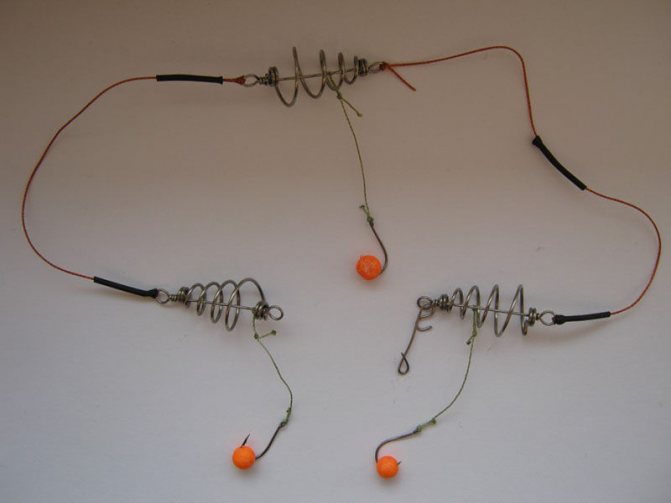
Making your own tackle
Let's look at how to make Inline tackle for safe fishing even if the fishing line breaks and when the feeder is freed from the equipment. To make it, you need to purchase a feeder feeder, a strong fishing line with a trimmer, a swivel, and hooks.
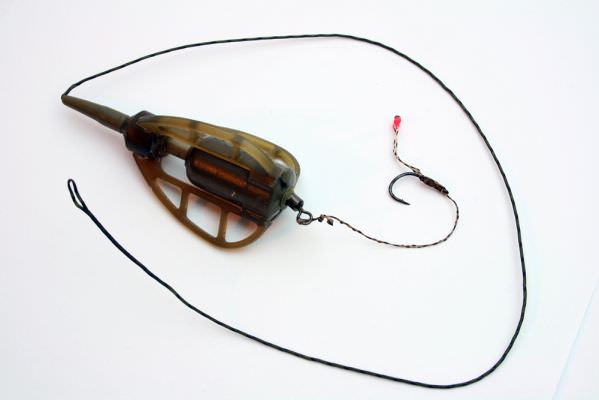
For installation:
- Tie a swivel to the fishing line and secure it with a rubber corkscrew so that the fastening is deaf.
- Place the line into the cavity of the feeder.
- Measure 30cm, make a loop.
- Tie to the main line.
- It is better to make a leash from a special material.
- You need to tie the fishing line manually so that it can withstand it if the carp goes into thickets and snags.
- The hook size should be No. 10.
Feeders and hooks are selected as for hair equipment when setting bait.
Advantages and disadvantages of gear
Let's look at the main advantages of this equipment:
- Instead of catching, complementary food is delivered in several portions at once, so casting for feeding does not need to be done many times.
- There is a high probability that the bite will occur much faster, since there are a large number of hooks.
- Convenience, simplicity and speed in carp fishing.
This type of gear also has its drawbacks.
These include:
- Low sensitivity. Because of it, it is very difficult to discern weak carp bites.
- The tip of the rod will only start working when the carp is hooked.
- There is also a possibility of hooks and leashes overlapping each other.
Types of gear for carp fishing
Catching carp is not easy. Often you come across trophies up to 8-10 kg, and a regular fishing rod can quickly break. When making it yourself, the main thing is the strength of the rod and the average diameter.
Kinds:
- is quite suitable ; you can also make it yourself.
- Float rod , as a popular tackle among fishermen, made from flexible walnut rods and strong fishing line. Suitable for fly rods, Bolognese rods, match rods, and plug rods. The main thing is to choose a fishing line of medium thickness and thick wire hooks.
- A variety of donks in the form of various feeders , which you can also prepare with your own hands. When catching carp, you can’t do without hooking, so you need to play with the feeders and do the wiring that way. The best fishing rod is a feeder rod, a rod with a spinning reel and a monofilament line with an elongation of 0.30 mm. When fishing for small specimens, homemade feeders, nipples, tops, and springs are suitable. There can be many options for self-production.
Required materials and tools
To make a carp killer rig you will need:
- Line with a diameter of 0.2 to 0.4 mm, depending on the expected size of the catch. For small fish in small ponds, 0.2 is enough, but in the case of trophy carp, 0.4 may be just right.
- Braided cord or fishing line with a slightly smaller diameter - it will go on leashes. In this case, braid is used more often, since it is softer and less alarming to carp.
- Lead sinker with an eye (this will make it possible to quickly replace it).
- Ready-made feeders or stainless steel wire and plastic tubes for making them yourself.
- Pliers, round nose pliers, swivels, carabiners, locking beads, hooks.
Carp and crucian carp are popular fishing targets, so there are many tackle options available to achieve good results. The equipment that kills crucian carp and crucian carp has established itself as one of the most effective used for non-sport fishing.
Equipment selection criteria
A flat bottom is conducive to carp fishing
It is better to fish with a feeder and a float with barbs to avoid injuries to the fish’s oral cavity. Carp also needs a strong fishing line with a light sinker with imitation stone, as well as a swivel and a bite alarm.

On a flat bottom you can use hair, sliding equipment.
Presence of driftwood
Carps love to hide under stones, among reeds and vegetation. This is problematic for anglers, since equipment can be quickly and irretrievably lost. But it is in hard-to-reach places that large fish are found and are rarely found in open spaces. These are lovers of water shelters and only feel safe there.
In such places it is better to use a (fairly) powerful rod up to 5 m in length, and the straighter the rod, the easier it is to control bites.
Before you start fishing, you need to build a stand to stabilize the fishing rod on the ground, and also mount:
- an electronic alarm with sufficient sensitivity, such as Pacific Rim;
- monofilament is suitable up to 0.35mm in diameter;
- anti-twist from a tube in the presence of shells and rocky bottom;
- safe clips for releasing the load when fish bites in conditions with a complex bottom relief;
- The streamers are quite heavy to allow the gear to quickly exit the water and not get stuck in reeds and algae;
IL
Preferred for carp, but difficult for fishermen. It is in waters with a muddy bottom that carp actively live.
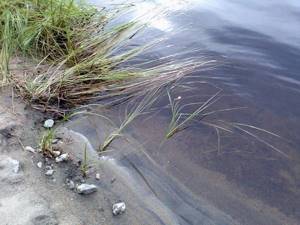
If there is such a bottom, the leash in the reservoir should be 20 cm long with a marker sinker at one end.
It is better to use a marker rod, which avoids many problems, as well as a float with the ability to stick.
The weight of the feeder should be approximately equal to the marker sinker so that it does not tip over when lowered to a depth.
A compact helicopter tackle for muddy bottoms, which is not capable of providing resistance upon contact with the sinker, is suitable. Feeders should be wide enough and light enough due to the silt at the bottom.
Fishing technique
After the tackle and bait are ready, you can start fishing. But first of all, you should learn about fishing techniques.
- Check the bottom of the reservoir. To do this, you need to throw a weight without hooks and find out if there are any possible holes or irregularities.
- Hang the tackle on the rod and fill the springs with bait.
- Throw a little fertilizer into the water.
- Throw the “crucian carp killer” tackle into the pond. When casting, you should move the rod back a little, then you need to move the rod a little so that the tackle smoothly sinks to the surface of the reservoir.
- Place the rod on the supports and let the sinker touch the bottom. Then set up a bite alarm.
- The cast should be repeated every 20 minutes.
Thanks to this fishing technique, not a single fisherman has ever complained about the lack of a bite. Therefore, you should safely use it, so as not to embarrass yourself later in front of your colleagues, who may also have gone fishing.
How to throw?
Before you start fishing, you need to choose a fishing spot.
Then fill the feeder with the bait that crucian carp like so much and throw it into the water using a slingshot. You need to take into account that the “crucian carp killer” tackle will be heavy, so you should cast smoothly. When the tackle touches the bottom, you need to:
- Pull up the fishing line;
- Fix the rod;
- Build bite alarms.
If the fish does not bite for some time, you should cast again. Supposedly, you need to cast the tackle every 20 minutes. It is best to change baits periodically to attract more fish.
Features of use
During each fishing period, fishing professionals advise using their own food. Fish have their own feeding habits at any time of the year. And the bait, which is made independently, can work regardless of bad or good weather.
In spring, soil should be added to the bait. It must be obtained from the reservoir where the fishing spot is planned. The dried and sifted soil should be mixed with bloodworms and the whole thing wrapped in gauze, dividing the fish food into balls. You can also mix millet with chopped worms.
As a summer bait, and depending on the appetite of the crucian carp during this period, it will be to use a plant-based feed composition with the addition of flavorings. The simplest ingredients are:
- Roasted sunflower seeds;
- Breadcrumbs;
- Powdered milk;
- Cereals;
- Semolina;
- Sugar;
- Cocoa;
- Vanilla.
They are used to prepare ordinary mastyrka, which is similar to dough.
In the fall, crucian carp will need protein products in their food, namely:
- Bloodworm;
- Food for aquarium fish;
- Dried daphnia.
You can make as many baits as you like, and it is always advisable to add strong smells to them to attract crucian carp.
Basic elements for carp fishing
- A rod up to 3-4m long as the main element of equipment for catching carp. A fiberglass spinning rod made in China will do just fine, which you can buy for 400 rubles. in a fishing shop. Fiberglass is not inferior to expensive carbon fiber and is suitable for catching large carp with dough bait up to 250 g.
- The reel is innovative, excellent for catching carp, as it is quite powerful and reliable, not inferior in performance to spinning models. But not suitable for beginners. The best option is to purchase an inertia-free feeder model from the company: salmo, okuma, cormopan.
- The leash can be invisible or neutral. It is better to choose a short leash for good visibility of bites due to the flat body of the carp. So that the weight is clearly visible to the carp and occupies a central position in the water in relation to the feeder. If you have a short leash, the casting distance of the casting equipment will increase significantly.
- Regular and monofilament fishing line is preferable. Some fishermen use braided cord, which is quite sensitive. The diameter of the fishing line for carp is 0.4-0.5mm. The best option is a specially purchased carp line in a store with a fairly high stretch coefficient. It will serve as an excellent shock absorber when fishing for large fish.
- The main thing is to select the sinker taking into account the terrain conditions and the weight of the bait , so that the equipment is held at the bottom regardless of the composition of the bait. She easily made the marks herself and quickly notified the fisherman about the beginning of bites.
- Hooks should be bent inward or bent back with a sting. The first option is best, as reliable and sharp hooks are quickly swallowed by the fish, which gives a greater chance of hooking.
What are folk rigs?
Probably, after reading the paragraph about choosing fishing lines, many fishermen found themselves slightly perplexed, because usually everyone advises using cords and fishing lines with minimal stretch. Yes, but only if you have to use equipment that requires accurate bite registration and timely hooking. Traditional rigs work on the principle of self-hooking, so the sensitivity of the rig has absolutely no importance.
Believe me: when the carp is on the hook, you will see it, even if instead of a rod you have a shovel handle...
The rigs that will be discussed work to suction the hook, which is why they are often called “nipples.” It was noticed by fishermen a long time ago that carp really like to suck on large lumps of bait, as well as cubes of pressed cake.
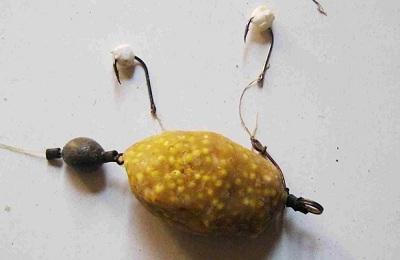
“Do-it-yourself carp fishing gear”
At some point, someone thought: “What, this could turn out to be an interesting piece of equipment! You can use a trick on carp by putting the hooks in a lump of bait...” The result of fishing with a “nipple” was simply amazing, so it quickly gained popularity among carp fish lovers.
At the moment, several types of nipples are known. The most popular are the nipple-spring, or “carp killer” and the machushkat. The difference between them is that in the first case, the spring is stuffed with dough-like bait, and in the second case, a cube of pressed cake is used as bait.
It’s difficult to say what works better. “Killer” is a purely pond equipment. It is used for carp only in reservoirs without a current. But on the makushatniks you can also successfully catch carp - a wild, river form of carp. In any case, I will tell you how to make both the killer spring and the crown spring with your own hands.
How to make a pacifier-spring?
The main element of the “carp killer” equipment is a spring feeder with a hollow core.
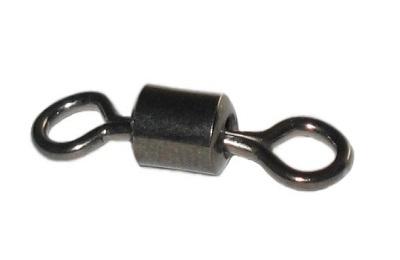
You can also use feeders with ears, but, in my opinion, this option is worse, because the number of nodes increases, as a result of which the reliability of the equipment decreases.
In addition to the spring, we will need:
- Thick braided line.
- Beads.
- Two sharp carp hooks.
- Swivel.
Manufacturing process:
- We cut off a half-meter piece of braid, thread one end into the swivel, pull it out about 10-15 cm, and fix the swivel with a clinch knot.
- We put two beads on the long end and drag them to the swivel.
- Next we put a sliding spring feeder on a long piece of cord
- We put on another bead. We pull the feeders and beads close to the swivel.
- Next, measure 7 centimeters at the long free end of the cord (we measure from the spring), and cut off the cord at this point.
- We tie a swivel to the end. At this stage, we will have a spring sliding between two beads secured with swivels. We also still have a loose leash formed when tying the first swivel.
- We attach a sharp carp hook to this leash. The length of the leash should be such that the hook reaches the middle of the feeder.
- We tie another leash with a hook to the lower swivel.
Well, that’s all – the “carp killer” rig is ready! Probably, many anglers have noticed that this rig is very similar to the “death of crucian carp” rig. Yes, that’s absolutely right - the design and operating principle are identical.
The only difference is that the carp killer is assembled with one large spring, and the death (killer) of the crucian carp is a chain of several small feeders.
Lure
The carp killer is stuffed with viscous, dough-like bait. You can achieve the desired consistency by adding a large amount of binding components, for example, semolina or clay, to the bait porridge.
Carp fishing techniques and tactics
When fishing, it is necessary to observe certain features and take into account subtleties to obtain the desired result.
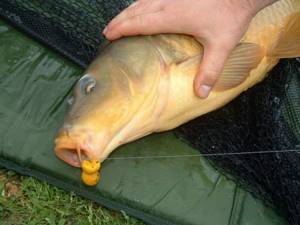
Carp is unpretentious to its habitat, but is quite shy and is rarely caught if the fisherman is awkward.
The main thing is to feed the fish spot, but not with too rich bait, because when the carp is full, the bite will immediately stop:
- Complementary food should be thrown into the same place, no more than 200 g every 1 hour, with the addition of flavorings, but without a strong odor, otherwise the fish can be quickly frightened.
- Carp are shy , so when fishing you need to remain quiet and it is advisable to move away from the fishing spot. Also, choose clothes that are darker in color with the shore and surrounding vegetation.
- As a fishing technique, you need to pay attention to the rod. A cone fishing rod that can compensate for the powerful jerks of the carp or a feeder tackle is suitable. Bait: corn, peas, boiled potatoes, bread, boilies.
- The bait clings to a hook or hair. So usually the bites on carp are confident. Although when swallowing the bait, the fish sucks it for a long time, tasting it, and only then takes it completely. This is manifested by light bites on the water, which fishermen also need to take into account.
- It is advisable to mount an electronic signaling device to the tackle , which will indicate the approach of fish.
- The tackle should sink to the bottom evenly and completely. Fishing requires careful and sedate retrieval to avoid line breakage when catching large fish.
- After the carp appears above the water , you need to use a landing net or hook.
Features of fishing techniques
There is nothing complicated in the technique of catching carp killer. After arriving at the pond, you need to choose a place and throw the equipment into it , after which all that remains is to wait for bites.
When fishing with a carp killer, it is usually impossible when the fish approached the smell of bait and began to eat it After it is hooked, there is usually a strong jerk, after which the line sags. When this happens, you can start playing.
Some people fish with a carp killer in a completely passive way . In this case, you can throw the gear into the water and not monitor it at all, periodically, once an hour or less, checking it and pulling out the hooked fish. But then the catches will be smaller, since after self-hooking it can free itself from the hook.
Carp: description and behavioral characteristics
Carp is a peculiar river species with characteristic habits. This is a nocturnal fish and prefers to feed exclusively at night; during the day it prefers to stay in holes and go out to feed in the evening or early in the morning.

Carp is a schooling fish and is rarely found alone. Only large individuals sometimes stray from their flock in strong winds and swaying reeds, swimming out of curiosity to find food for themselves.
The fish is cunning and agile, quite picky about complementary foods and fishermen should select them taking into account the time of year.
In spring and autumn, simple plant foods are preferred, in autumn – animal foods. Making your own pearl barley porridge, steamed, hominy, dough is suitable. In autumn, carp feed more on worms, maggots, larvae, bite activators, i.e. any soft bait.
What to use as bait
The choice of bait depends on the time of year. Vegetable foods are suitable in summer:
- bread;
- pearl barley;
- peas;
- corn;
- potato;
- semolina;
- dough.
In spring and autumn, it is better to use animal bait:
- maggot;
- worm;
- bloodworm.
If there are no bites for a long time, then the tackle needs to be re-thrown. Fishing efficiency will be ensured by a 10-minute interval between casts. Using 3 hooks allows you to experiment by placing different baits at the same time. For example, on one hook - maggot, on the next - pearl barley, on the last - bread. During the fishing process, the most catchable bait is determined, which will be rationally used on all hooks.
Habitats
Carp prefer to hatch in wide and deep areas of reservoirs with weak currents without a hard rocky bottom. Fish loves warm places and not too deep waters.
Often found in shallow water, when the water warms up strongly, it prefers to go deep into the reservoir, old riverbeds, flooded quarries or small rivers. Hides under bridges with aquatic vegetation and many reeds.
Carp winter in deep holes. It wakes up around March after the lilac blooms, begins to spawn in places convenient for itself, but tends to migrate over long distances. Closer to winter, it gathers in schools of 1000 heads.
Selects secret bays in rivers for wintering. But it happens that in sunny, clear weather, even in late autumn, it jumps out of the water in order to feed early or in the late afternoon in cloudy weather. He considers river reeds and floating islands to be ideal shelter.
Carp rigs with feeder
In-line
One of the simplest, most effective and popular options for installing equipment. Its essence lies in the fact that the anti-spinner passes directly through the center of the sinker. Inline is often used when fishing on a pond or small lake, because there is no need for long casting.
Another advantage, in addition to the simplicity of knitting, is the fact that when using this type of installation, the carp will encounter the mass of the entire pear-shaped sinker. Therefore, hooking will be very effective.
This is achieved due to the close location of the leash in relation to the center of gravity of the sinker. If you change its shape from pear-shaped to flat or even use a “bump”, then the inline will be suitable for fishing in the current.
Thus, when using different sinker configurations, this type of installation becomes unique. The main disadvantages of inline are unsatisfactory aerodynamics during casting and limited range.
Assembly method:
- The swivel is tied to the fishing line.
- After this, a rubber stopper is firmly tied.
- The line is pulled into the feeder.
- The fishing line is stretched 35 centimeters further and a loop is made from it.
- For a leash you need monofilament 10-12 centimeters long.
- Next, the hook, which has a hair rig, is attached.
Carp equipment In-line
Killer of crucian carp and crucian carp
For installation you will need:
- braided line with a diameter of 0.13 mm;
- monofilament with a diameter of 0.2 mm;
- “cage” type feeder, which is equipped with a clasp.
The choice of hooks will depend on the size of the fish:
- Number 12 or 15 are suitable for small fish;
- 7 and 8 - for a larger catch.
Build process:
- The line is wound onto a reel, after which it is pulled into the rings of the rod.
- Then the line is bent in half a meter from the end of the fishing rod. A knot is tied 20 centimeters from the edge.
- The sinker along with the feeder is attached to the resulting loop.
- A twenty-centimeter long segment is tied to the remaining segment. It is designed for a leash.
Equipment “Paternoster”
Hair hook rig
The main feature is that there is no need to put bait on the hook. It will go down the carp's throat when it swallows. You'll have to use auto hooking. Hair equipment requires a hook for installation, which must have maximum strength, and hair (soft and small in diameter).
The assembly proceeds as follows:
- The bait is attached at a distance of 2 centimeters from the hook.
- The hair is wrapped several times to be able to lengthen it later.
- The hair rig is ready!
Hair hook rig
Biting calendar
- Winter is not a good time to catch carp. At this time, he is lazy and prefers to spend little by little the reserves accumulated over the summer.
- Spring , when accumulated reserves run out, carp begin to come out in search of food. A very successful time for fishing is the end of April, when the carp are active and bite well. In mid-May it begins to spawn and the bite stops.
- Summer , when carp are quite active and are constantly looking for food in comfortable conditions exclusively in warm water. In August, with the arrival of cold weather, a strong hunger begins and good hot days are the best time for biting. Until the onset of cold weather, you can have fun with good catches until about mid-October.
- Autumn , with the onset of cold weather, fish activity stops, but until the first night frosts it is quite possible to fish until the rivers are covered with ice. Bites are active until lunch, although most of the time the carp prefers to stay in wintering pits.
Required components
Hooks
First decide on your hook. For catching carp, three types are often used: with a sting curved inward or bent back, as well as hooks with a long and concave shank.
It is preferable to use those that have a tip curved inward. When used, the chances of effective hooking and reliable swallowing by the fish increase.
Leashes
In carp fishing, floating, invisible, sinking and neutral leashes are used.
Their choice will depend on taking into account the characteristics of all types:
- A long leash scares the carp less, but the fish will have more time to free themselves from the hook.
- With a short leash, the bite can be noticed literally immediately, but it will be more frightening.
Therefore, when fishing for carp, it is preferable to use them because it has a more elongated body.
Combined leash for carp fishing
Sinkers
They are one of the most important components when fishing for carp.
In order for fishing to be successful, the following characteristics of the weight are needed:
- It should firmly hold the equipment in any type of bottom in any area.
- The sinker must provide excellent line pressure for early notification of a bite.
- Conditions must be provided for the location of the bait at the required distance.
Sinkers for carp fishing
Anti-twist
This is required when using the safety clip. When choosing, pay attention to the smell of the anti-twist.
It sounds strange, but carp are susceptible to them, so a good fisherman needs to choose quality products that do not have a specific smell. The anti-twist tubes should not shine, so as not to scare away the fish.
Anti-twisters with three types of floats - spindle, ball, tablet
Swivels
The main functions of these devices are:
- Attaching the stopper in the place where the sinker connects.
- Prevent twisting of equipment.
The most versatile and popular are number 10 swivels. They fit any clip. When choosing a swivel, remember that the rule “bigger is better” applies here.
Swivels
Tips and tricks
The main feature when installing gear on carp is the free movement of the feeder along the fishing line.
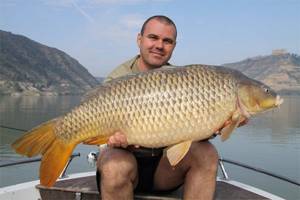
Experienced fishermen advise:
- When installing the tackle, use a strong fishing line and securely fasten the leashes so that there are no breaks.
- Use high-quality fishing rods that will not break when fishing for fish.
- To increase the strength of the fishing line, use plastic for the material.
- Do not raise the fishing rod too much above the water, otherwise all the fish can be quickly frightened.
- If there are no bites, then you should not immediately replace all the equipment; you can replace only part.
- The equipment must be reliable and you cannot skimp on material. Some items can be purchased in specialized stores.
- To achieve efficiency, you should prepare for fishing, analyze the depth of the reservoir, as well as the bottom;
- Feed the fishing spot a few days in advance.
The main thing is that this or that installation of equipment fully complies with all the features and conditions for carp fishing.
Carp rig, carp killer, carp rigs
Catching large carp is still different from simple fishing with a fishing rod or spinning rod.
To learn all the intricacies of carp fishing, you need to devote the greatest amount of time to practice. Now let's move on to the theory. If you know this information, you can significantly reduce the cost of purchasing gear in a special store.
Tackle for carp
Carp is a very strong and cunning fish. There are a lot of people who want to catch this fish, but special equipment is needed to hunt for carp.
Murderer
The tackle, which is called a carp killer, is an improved type of tackle of an ordinary feeder load-feeder. There is a huge variety of such gear, so you need to carefully study all the nuances so as not to stumble upon non-functional gear in the store.
But you can also make such equipment yourself. The main feature of the killer tackle is that in this case a large number of hooks and a load of feeders are used.
In fact, the number of reels can be up to five, and the number of hooks up to ten, while using various attachments, feed and bait.
How to do it yourself?
To catch this fish, you need to have an idea of how to make the most correct tackle for carp. The carp fish is suspicious and difficult, so to get it, you need to try.
This kind of gear is easy to make. There are two types of this equipment: blind and sliding.
For deaf fish, you should purchase three feeder weights for one tackle and secure them to a braided rope or a very thick fishing line, the distance between them should be about 20-30 centimeters from each other.
The most important thing is that the last feeder load is the heaviest. Then on leashes, the thickness of which is approximately 0.25-0.3.
Of course, the size of the hooks also depends on the size of the carp, but an important point should be taken into account: it is better to use smaller hooks than large ones.
And for sliding, it is necessary to use lead pellets as sliding boundaries on both sides of the feeder weight.
What to make it from?
In order to make such tackle with our own hands, we will need:
- 2 or 3 hooks;
- Rubber stoppers;
- 2-3 springs, which are intended for feeder fishing;
- 1 meter of fishing line or cord;
- Swivel with latch;
- And the cargo.
How to do it right - step by step instructions:
- It will be best if you find springs that have a tube inside. We pass the main fishing line through this tube. It is necessary to secure each spring with rubber stoppers, the distance between which should be about 10-15 centimeters.
- To test the rod, you need to select the weight, namely, attach a weight to the end of the main fishing line. A leash with a hook must be attached to each spring. The length of the leash itself should be approximately five centimeters.
- At the other end of the main line we knit a swivel with a latch.
Advantages and disadvantages of gear
Let's look at the main advantages of this equipment:
- Instead of catching, complementary food is delivered in several portions at once, so casting for feeding does not need to be done many times.
- There is a high probability that the bite will occur much faster, since there are a large number of hooks.
- Convenience, simplicity and speed in carp fishing.
This type of gear also has its drawbacks.
These include:
- Low sensitivity. Because of it, it is very difficult to discern weak carp bites.
- The tip of the rod will only start working when the carp is hooked.
- There is also a possibility of hooks and leashes overlapping each other.
How to catch killer tackle?
Bottom fishing has been known since ancient times, but the popularity of this method of catching carp lost its popularity several decades ago.
However, in the last few years it has become popular again, and in addition, it is being improved and modernized.
When feeder rods began to appear, high-strength polymers began to be used in fishing lines, as well as electronic fishing aids, bottom fishing again became a well-known and even sporting method of “hunting.”
The fisherman must take into account many main nuances before designing a bottom fishing rod with his own hands.
It is worth considering before making a tackle for carp that this fish, although quite common, is timid.
Particularly experienced carp can easily deceive an inexperienced fisherman.
The fish can simply eat a small part of the bait, and then let it go at the first feeling of threat. From the outside it may even seem that this is not the manipulation of the carp, but the wind or the flow of water.
Apart from the size of the fishing line for creating bottom tackle, the rod itself is no different from a regular one. If you do not have a special desire to catch large carp, then you can choose a fishing line with a thickness of 0.2 mm.
This line is enough for fish weighing up to four kilograms. Before you start making equipment, you should understand that there are basic tools for this type of fishing.
The main working part could be as follows:
- With a sinker, which is located at the end of the main line, and with a hook, which is attached to the side leash;
- The sinker is installed on a separate leash, and the hook on the main fishing line;
- The sinker can be either blind or sliding, and is attached to the main fishing line, to which the hook is also attached.
To make such equipment with your own hands, you need to understand the very nature of the reservoir, know about the fish you want to catch, whether there is a current in this reservoir, and also try and rely on your own fishing tastes.
In order not to make mistakes, you need to include logic, personal experience and common sense. This way and only this way, you will be able to catch a large carp.
Subtleties of fishing
There are many subtleties in carp fishing. It all lies in the correct selection of bait, tackle, bait, as well as fishing tactics.
The main thing you need to decide when you arrive at the reservoir is where to catch carp.
The thing is that they are lovers of warm water, where there is at least some living life, and carp come in most cases in shallow water.
Therefore, you need to decide on the choice of depth in favor of one and a half to two meters.
The wind is not a hindrance to us, it can even help when fishing, since carp behave less carefully in such weather.
For your convenience, you should not sail too far from the shore. The most optimal distance will be about thirty meters.
The first thing you need to do when you are located in place is to prepare a feeding spot in order to lure the fish.
This spot should be formed from pre-prepared bait, which consists of a poly-mixture with large particles and low nutritional value.
After such bait, the carp will not get enough and will want something more substantial. This essential will be the bait on the hook.
Next, having chosen the direction, we make the first cast and then you need to fix the fishing line in the reel clip. Before casting, determine some point to which you will focus.
Now we wait for the moment when the feeder lands on the bottom of the reservoir.
We make 1-2 turns with the reel, and then shake out the food with a fairly sharp movement of the rod. After this, the feeder should be completely empty.
After feeding the fish, we begin to attach a leash with a hook in a loop-to-loop manner.
For convenience, you can use ready-made leashes. The hook must have a pressed point and a short shank.
Now we put a dung worm on the hook, thereby piercing it in three places. This is done so that the carp cannot pull it off.
But it is best to have various baits with you, for example, maggots, moths or pasta.
When we have made the cast, we wait about five to ten minutes, after which we make a second cast if the bite does not happen.
It is best if you have a second feeder with you just in case, so that in an unforeseen situation you do not lose a lot of time.
Adviсe:
- You can use foam balls for some of the hooks. This allows some baits to avoid landing completely on the bottom. This technique is very useful in order for more fish to notice your equipment.
- It will be better if you use a variety of bait for the springs. This will give you the best chance of tempting the carp.
- When diving, your rig will be able to lie flat on the bottom and will not get tangled when thrown if you attach the heaviest spring or weight to the end.
Once again it is worth saying that carp is a very worthy fish. It’s worth hunting for this specimen, because it will be a very exciting and interesting activity for you. Happy fishing!
Source: https://superkaras.ru/lovlya/karp/karpovaya-osnastka-ubijca-karpa.html
Selection of equipment depending on fishing conditions
Smooth bottom
Use the paternoster if there is crucian carp in the bycatch and the flat method when targeting.
This is where a simple and effective hair rig comes in handy.
driftwood
It’s better not to fish in snags at all. But if there is no choice, then use Inline and oval weights.
IL
Only paternoster and flat method. The first one, having drowned in the silt, will not take the bait with him, and the second one simply will not drown due to the shape of the feeder.
- We recommend that you wet the knot before tightening it. This will strengthen it and prevent the line from breaking.
- If there is no bite, there is no need to change the equipment completely, only a partial change is enough.
- In order to achieve an even and smooth position of the bait on the bottom, it is best to attach a spring or sinker to the tip of the fishing line.
- It is best to use different types of bait in springs. This will significantly increase the chance of attracting carp.
During the period of open water, everyone chases crucian carp together. There are a lot of techniques and methods for catching this sneak, but the most effective gear for catching it is considered to be the “crucian carp killer”.
This tackle combines both a “feeder” and a “pacifier”. This tackle can be easily bought in a store, and if it is not available, then you can make it yourself without any problems.
